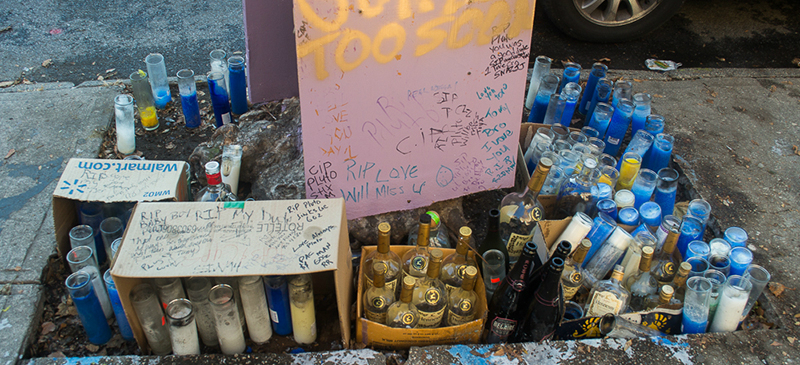By Matt Collette, Renny Grinshpan, and Nicola Pring
Kareem Marrow knelt down in front of a tree on E. 96th Street in Brownsville on a cold Saturday afternoon. With a can of go ld spray paint in his hand, he retraced the fading words on a memorial for Mervyn Spann.
ld spray paint in his hand, he retraced the fading words on a memorial for Mervyn Spann.
Candles and empty bottles surround a tree covered with notes and photos of Spann, who was shot dead inside his brick row house apartment a month ago. One of the most recent notes—written on a photo of a smiling Spann—is from his 8-year-old daughter. “I love you and I miss you Dad,” she wrote in thick black ink.
To his family he was “Pluto.” To his neighbors in Brownsville he was generous with advice, time, and money. But to most everyone else, the 25-year-old was just another young man with a rap sheet who was killed in Brooklyn.
News reports—most just a few paragraphs long—portrayed Spann as a man who’d had his share of run-ins with the cops. But that was a long time ago, according to friends and neighbors who said he’d turned his life around and was eager to move out of Brooklyn altogether.
“That was 10 years ago, when he was younger,” said Marrow, a man in his fifties who describes himself as a kind of father figure on this tight-knit block. “When I met him, he wasn’t the person I saw on the news.”
The man Marrow knew was quiet, but social. He worked as a mechanic, saved his money, and would pay to send his mother, who lived a block away with the rest of the family, on vacations to Trinidad, where her family lived. He’d saved up enough money and bought his dream car—a BMW—for his birthday this July.
Media reports said he’d been arrested 10 times, eight of those before he turned 18. Police painted his death as a drug deal gone wrong, but people who knew Spann said he turned away from crime when his daughter was born. “Having a baby girl, I think, pushed him to be a better man,” said Marrow’s wife, Gladys. Spann looked out for her kids, too, she said, telling them to stay in school and be respectful of their parents. Spann seldom brought his daughter from her mother’s house where she lived to his block.
He’d been planning a move to Florida, a place he’d often go to escape his life in Brownsville. Two days before he died, Spann told Marrow he was saving money to move to Miami permanently.
Spann’s story is jarringly common in Brownsville. While violent crime has decreased across New York City, homicides are a part of life here. Of the about 41 homicides in Brooklyn since August, six were in this neighborhood near the end of the 3 train.
There are reminders of violence everywhere here, in memorials to the dead. A few blocks away, for example, there’s a memorial to another victim of homicide, this one outside a vacant lot beside People’s Baptist Church. It is for 26-year-old Robert Martin, who was killed last month—this time in a daytime shooting outside PS 183. There are two signs, one with his picture on it, covered in messages to Martin, nicknamed “Pudge,” written in black marker. There are dozens of prayer candles underneath the signs. Dried red and blue wax is splattered on the sidewalk.
Continue east and there’s another, this one for Antiq Hennis, the 16-month-old boy who was shot in his stroller on Sept. 1 by a man allegedly aiming for Hennis’ father. There are stuffed animals hanging from a tree outside the boy’s home at 163A Riverdale.
Police patrolled Spann’s block for a week after the shooting, with an especially high presence the day of his wake. But that didn’t last long. Detectives in the 67th Precinct confirmed Thursday that the case remains unsolved, with no suspects or new information to release beyond their initial report.
“When I was coming from the wake in the car I said, ‘I know they are gonna forget about him,’” said his neighbor, Vanessa Riley. “The city forgot him. The cops forgot him.”
Marrow said he won’t let his street forget Spann, though. He watches over the memorial, touching up the paint and replacing photos, a way to keep some part of Spann on a block that feels different since the killing.
“It’s a ghost town. People don’t come out anymore,” Marrow said. “It’s all changed.”




Leave a Reply